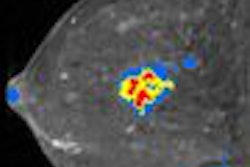Recent clinical research has suggested an apparent decline in the mammography screening rate in women over the age of 40. If this is in fact the case, is this trend cause for concern in the Medicare population?
A 2007 study by Breen et al at the National Cancer Institute assessed the trend in mammography rates from 1987 through 2005, and found that screening rates in a general U.S. population declined from 70% in 2000 to 66% in 2005 (Cancer, June 2007, Vol. 109:12, pp 2405-2409). Although small, this decline may be cause for concern because it signals a change in what had been a steadily growing mammmography screening rate, according to Breen.
In a study published this month in the Journal of the American College of Radiology (JACR), Dr. Vijay Rao and Dr. David Levin and colleagues at Thomas Jefferson University Hospital in Philadelphia sought to explore the question of whether Breen's research indicates cause for concern in the Medicare population as well. What they found was that although the use of mammography in this group has increased overall since 1996, the 2005 rate for Medicare beneficiaries does seem to be lower than recommended by the American Cancer Society (ACS) (JACR, May 2008, Vol. 5:5, pp. 652-656).
The team used data from the Centers for Medicare and Medicaid Services (CMS) Physician/Supplier Procedure Summary Master Files for 1996 through 2005, which are summary tables for the nationwide Part B datasets for all beneficiaries in Medicare's fee-for-service program, or about 85% of the total Medicare population.
Rao and colleagues analyzed the following CPT and HCPCS codes:
- 76090: Film diagnostic mammography, unilateral
- 76091: Film diagnostic mammography, bilateral
- 76092: Film screening mammography, bilateral
- G0202: Digital screening mammography, bilateral
- G0204: Digital diagnostic mammography, bilateral
- G0206: Digital diagnostic mammography, unilateral
The study found that during the study period, overall mammography use increased, with screening tripling the diagnostic rate by 2005.
Mammography utilization, Medicare fee-for-service population, 1996 to 2005
|
Rao and colleagues also analyzed data for the period between 2000 and 2005 and found that there were additional increases in mammography use during this time frame.
Mammography utilization, Medicare fee-for-service population, 2000 to 2005
|
The study found that there was an 11% increase in screening mammography between 2000 and 2005.
Rao's team noted that the 2005 figure of 39,363 studies per 100,000 Medicare beneficiaries is lower than it should be if most women in the Medicare population are getting annual mammograms after age 40, as the ACS recommends, and suggested a number of possible reasons for this:
- A decrease in the number of mammography facilities and radiologists interpreting mammograms between 2001 and 2004, due to low reimbursement and difficulty recruiting new radiologists
- Fewer educational and public health initiatives
- An increase in the number of uninsured women and higher copayments for outpatient visits
- A decrease in the incidence of breast cancer due to a decline in the use of hormone-replacement therapy
Digital mammography is still very expensive, Rao's team wrote, but its integration into clinical practice continues rapidly, perhaps due to the conversion to electronic image records throughout radiology practices: Digital mammography increased from 2.2% of all mammography in 2002 to 10.4% of all mammography in 2005.
The team suggested that because digital mammography is perceived as new and better technology, it's possible that as it becomes increasingly established, more and more women will be encouraged to go for annual screening mammograms.
By Kate Madden Yee
AuntMinnie.com staff writer
May 27, 2008
Related Reading
Falling breast cancer rates attributed to drop in HRT, not drop in mammograms, August 24, 2007
Drop in U.S. mammography rate worries cancer experts, May 14, 2007
Combination HRT linked to lower-risk breast cancers, May 10, 2007
ACS study cites mammo use behind cancer drop, May 3, 2007
Mammography use in U.S. meets national goals, study shows, June 30, 2005
Copyright © 2008 AuntMinnie.com




















